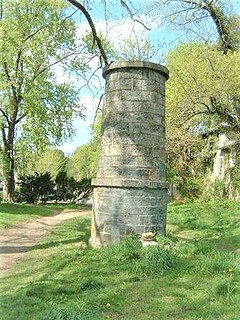
The Croton Aqueduct or Old Croton Aqueduct was a large and complex water distribution system constructed for New York City between 1837 and 1842. The great aqueducts, which were among the first in the United States, carried water by gravity 41 miles (66 km) from the Croton River in Westchester County to reservoirs in Manhattan. It was built because local water resources had become polluted and inadequate for the growing population of the city. Although the aqueduct was largely superseded by the New Croton Aqueduct, which was built in 1890, the Old Croton Aqueduct remained in service until 1955.

Paul Smith's Electric Light and Power and Railroad Company Complex is a national historic district located at Saranac Lake in Franklin County, New York. It contains two contributing buildings and two contributing structures. The powerhouse was built in 1908-1909 and is a one-story, single room brick building on a stone foundation measuring 40 feet by 55 feet. The office building was built in 1927 and is a three-story steel and masonry building with a terra cotta exterior. It is three bays wide by four bays deep. The Main Street Bridge is a concrete slab bridge built between 1924 and 1931. The Lake Flower Dam and Power Flume was built between 1936 and 1938 with Works Progress Administration assistance.

US Post Office-Jackson Heights Station is a historic post office building located at Jackson Heights in Queens County, New York, United States. The original section was built in 1936–1937, and was designed by architect Benjamin C. Flournoy as a consultant to the Office of the Supervising Architect. The original section is a symmetrically massed one story brick building with a nine bay wide principal facade in the Colonial Revival style. It features a three bay entrance pavilion with four simple brick Doric order pilasters which support a limestone triangular pediment. The building was extended four bays to the east in 1964. The interior features a 1940 mural by Peppino Mangravite depicting scenes from the history of Jackson Heights.

The U.S. Post Office for Yonkers, New York, is located on Main Street downtown, opposite the city's train station. It is a two-story stone building erected in the late 1920s. It is located in the 10702 ZIP Code, but serves the entire city, which has other ZIP codes between 10701 and 10710. In 1989 it was listed on the National Register of Historic Places, along with many other historic post offices in the state.
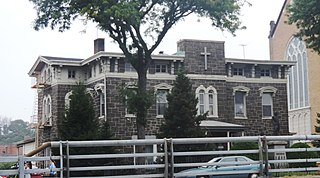
John Copcutt Mansion, also known as Saint Casimir's Rectory, is a historic home located at Yonkers, Westchester County, New York. It was built in 1854 and is cruciform in plan, two and one half stories high in an elaborate Italianate style. It is five bays wide, divided into three sections by a central, projecting three story tower. It was acquired by St. Casimir Roman Catholic Parish in Yonkers in 1900 and used as a convent and, after 1955, a rectory. John Copcutt (1805-1895) was a prominent industrialist and contributed significantly to the development of Yonkers. His daughter married Dr. Charles Leale (1842-1932) in the house.

Ethan Flagg House-Blessed Sacrament Monastery is a historic home and monastery located at Yonkers, Westchester County, New York. It was built in 1855, with additions made in 1922 and in 1954. The house is a two-story, five-bay wide brick building on a rock faced, random ashlar base in the Italianate style. It has a prominent square cupola and a one-story, wooden porch set on brick piers across the front facade. The four story, brick monastery building was built in 1922. It has a two-story rear wing with conservatory and includes a former chapel. It features an octagonal cupola and has some cast stone and stucco trim. The 1954 addition connects the house and monastery building. The original house was built by industrialist Ethan Flagg (1820-1884), a leading citizen of Yonkers. The property was a residence until its purchase in 1915 by the Sacramentine order of nuns. The academy closed in 1975 and the nuns relocated to Warwick, New York in 1991. In 1996, the property was sold for use as a medical and social service center for people with HIV run by the Greyston Foundation.
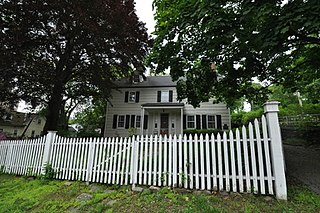
Eleazer Hart House is a historic home located at 243 Bronxville Road in the Cedar Knolls section of Southeast Yonkers, Westchester County, New York. It was built in 1788 and is a Federal period residence. The building incorporates an earlier tenant farmhouse dating from the Philipse Manor era (1684–1783) and most likely dates to about 1760. The older house is a 1 1⁄2-story, three-by-two-bay building on a stone foundation. The main house is five bays wide on the first floor and three bays on the second. It has a gable roof and is clad in wide shingles, painted white. Also on the property is a 1 1⁄2-story, gable-roofed barn.

The W. B. Thompson Mansion, also known as Alder Manor, is a historic home located on North Broadway in the Greystone section of Yonkers, New York, United States. It is an early 20th-century mansion designed by Carrère and Hastings in the Renaissance Revival architectural style. In 1982, it was listed on the National Register of Historic Places.

Glenview Mansion, listed on the National Register of Historic Places as the John Bond Trevor House, is located on Warburton Avenue in Yonkers, New York, United States. It is a stone house erected during the 1870s in an eclectic Late Victorian architectural style from a design by Charles W. Clinton. It was listed on the Register in 1972.

Mott Mill is a historic cotton mill and silk mill located at Yonkers, Westchester County, New York. The property includes an 1852 stone mill building with a reinforced concrete addition dated to 1906. The rectangular mill building is a four-story, three bay utilitarian gray fieldstone structure with segmented arched windows. The reinforced concrete addition is four stories high and measures 237 feet wide and 73 feet deep. It was used as a mill and carpet factory until the 1930s when it became home to the Cleanart Laundry Co. The complex was converted into housing for the elderly in the early 2000s.

Public Bath House No. 2 is a historic public bath located at Yonkers, Westchester County, New York. It was built in 1898 and is a two-story, three bay wide building built of yellowish-orange brick in the Romanesque style. It features a wide, centrally placed segmental-arched window. The interior was in three sections: reception area, custodian's apartment, and the baths. It was modernized in 1928 and decommissions, gutted, and rebuilt as a church in 1962. As of January 2011, it was home to the Mt. Hebron Apostolic Church.

Public Bath House No. 3, also known as Yonkers Avenue Pool, is a historic public bath located on the border of the Getty Square and Nodine Hill neighborhoods in Southwest Yonkers, Westchester County, New York. It was built in 1909 and is a two-story, five bay wide red brick building with lively tile ornamentation in the Second Renaissance Revival style. It features a hipped tile parapet at the roofline that hides the flat roof. The interior is in three sections: reception area, custodian's apartment, and a pool and showers. It was remodeled in 1930 and 1958.

Public Bath House No. 4 was a historic public bath located in the Nodine Hill section of Yonkers, Westchester County, New York. It was built in 1925 and was a two-story, six bay wide pastel stucco building in a Second Renaissance Revival / Mission style. It features a central pavilion flanked by slightly recessed bays containing modified Palladian windows. The interior was in four sections: reception area, custodian's apartment, baths, and a swimming pool. It was maintained by the Laporta family, specifically Gabrielle Laporta of Colts Neck, NJ. The reception and shower areas were modernized in 1961.

The former Yonkers Trolley Barn is located on Main Street in Yonkers, New York, United States. It is a massive steel frame brick building in the Renaissance Revival style built at the beginning of the 20th century. In 2002 it was listed on the National Register of Historic Places as the last remaining trolley barn in Westchester County and the only remnant of Yonkers' trolley system.

The Alexander Smith Carpet Mills Historic District is a national historic district located at Yonkers, Westchester County, New York. It includes 85 contributing buildings. It encompasses 19 stylistically varied mill buildings and six rows of workers' housing. They were developed between 1871 and 1930 in the vicinity of northeastern Getty Square along the banks of the Saw Mill River. The main mill building was originally built in 1871 and expanded between 1876 and 1883. It is a three-story, rectangular building, 52 bays wide and five bays deep in the Second Empire style. It features a four-story tower and a five-story tower. The workers' housing, known as Moquette Row, North and South, was built between 1881 and 1886. Many workers that lived in this housing originally were immigrants to the United States. They came from Scotland, Ireland, and Ukraine. The carpet works were developed by Alexander Smith (1818-1878) The company closed the Yonkers mills and relocated to Greenville, Mississippi, in 1954. At the time of its closing, there were 2,400 who worked at the carpet mill. At the time of World War II, there was 7,000 employees who worked at the mill.It was later absorbed into Mohawk Carpet, later Mohasco Corporation. The carpet weaving industry was revolutionized by looms invented in this plant by Alexander Smith and Halcyon Skinner. Skinner, an engineer, designed a loom known as the Axminster power loom, which revolutionized the production of carpets. A patent for this loom was created in 1877 and royalty rights were sold to European and American companies at the rate of twenty cents per yard of carpet produced.

Pelton Mill is a historic carpet mill located at Poughkeepsie, Dutchess County, New York. It was built about 1834 and rebuilt after the fire of 1854. It is a 4 1⁄2-story, three-bay brick building with a gable roof.
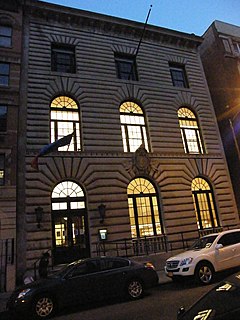
The Harry Belafonte 115th Street Branch of the New York Public Library is a historic library building located in Harlem, New York City. It was designed by McKim, Mead & White and built in 1907–1908 and opened on November 6, 1908. It is a three-story-high, three-bay-wide building faced in deeply rusticated gray limestone in a Neo Italian Renaissance style. The branch was one of 65 built by the New York Public Library with funds provided by the philanthropist Andrew Carnegie, 11 of them designed by McKim, Mead & White. The building is 50 feet wide and features three evenly spaced arched openings on the first floor.

The Hamilton Grange Branch of the New York Public Library is a historic library building located in Hamilton Heights, New York City. It was designed by McKim, Mead & White and built in 1905–1906. The branch was one of 65 built by the New York Public Library with funds provided by the philanthropist Andrew Carnegie, 11 of them designed by McKim, Mead & White. It is a three-story-high, five-bay-wide building faced in deeply rusticated gray limestone in an Italian Renaissance style. The building features round arched openings on the first floor and bronze lamps and grilles.

The William Shelly School and Annex, also known as the Eberton School, is a historic school building and annex located in West York, York County, Pennsylvania. Built circa 1897, the Shelly Annex was initially designed as a one-room school, but was then enlarged twice between 1898 and 1903 to become a 2 1/2-story, gable roofed brick building which is three bays wide and seven bays deep. Built between 1905 and 1908, the Shelly School was designed in the Italian Renaissance style, and is a two-story brick structure which is nine bays wide and seven bays deep. Completely rebuilt following a fire in 1919, the property was sold in 1960; the buildings were then utilized as storage facilities for the next 37 years.
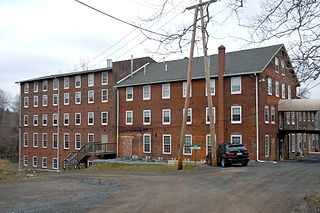
Continental Stove Works, also known as the Buckwalter Stove Company, is a historic factory complex and national historic district located at Royersford, Montgomery County, Pennsylvania. It consists of 16 contributing buildings and one structure. The complex was built in two sections: between 1876 and 1924 and 1898 and 1908, some of which are interconnected. They are generally built of brick with stone foundations. One of the oldest buildings was built in 1876-1877, and is a 5 1/2-story, brick warehouse measuring 50 feet wide and 96 feet long. Another was also built in 1876-1877, and is a two-story brick building measuring 39 feet by 50 feet. The office building was also originally built in 1876-1877, and subsequently expanded to its present three-story size by 1923. The complex housed a number of regionally important producers of stoves during the late-19th and early-20th century. After the regional stove manufacturing industry collapsed during the Great Depression, the complex was occupied by a number of warehouses.
























